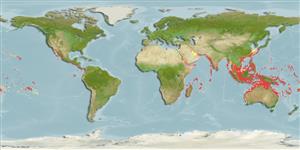分類 / Names
俗名 | 同種異名 | Catalog of Fishes(屬, 種) | ITIS | CoL | WoRMS | Cloffa
Teleostei >
Eupercaria/misc (Various families in series Eupercaria)
鱸形目 (Various families in series Eupercaria) >
Scaridae (Parrotfishes)
鸚哥魚科 (Parrotfishes) > Scarinae
Etymology: Scarus: Greek, skaros = a fish described by anciente writers as a parrot fish; 1601 (Ref. 45335).
Environment: milieu / climate zone / depth range / distribution range
生態學
海洋; 半鹹淡水 礁區魚類; 深度上下限 1 - 90 m (Ref. 89642). 熱帶; 31°N - 35°S, 21°E - 77°W
Indo-Pacific: Persian Gulf (Ref. 80050); Red Sea and Algoa Bay, South Africa (Ref. 5490) to Rapa and Ducie islands, north to southern Japan, south to Perth, New South Wales. Likely at Seychelles (Ref. 1623). Eastern Pacific: Gulf of California to Ecuador (Ref. 5227). Eastern Mediterranean: off the coast of Shiqmona, first Lessepsian immigrant of Family Scaridae (Ref. 45081).
印度-太平洋: 到拉帕島與迪西島的紅海與南非奧歌亞灣 (參考文獻 5490), 北至日本南部, 南至柏斯,新南威爾斯。 或許在塞錫爾群島.(參考文獻 1623) 東太平洋: 加州灣到厄瓜多.(參考文獻 5227) 地中海東部: 外海的 Shiqmona 的海岸, 第一個鸚哥魚科的雷賽布遷移.(參考文獻 45081)
Length at first maturity / 大小 / 重量 / 年齡
Maturity: Lm ?, range 49 - ? cm
Max length : 75.0 cm TL 雄魚/尚未辨別雌雄; (Ref. 90102); common length : 30.0 cm TL 雄魚/尚未辨別雌雄; (Ref. 55763); 最大年齡: 13 年 (Ref. 42001)
背棘 (總數) : 9; 背的軟條 (總數) : 10; 臀棘: 3; 臀鰭軟條: 9. This species is distinguished by the following characters: median predorsal scales 6-8 (usually 7); 3 scale rows on cheek, 1(6-7), 2(6-9), 3(3-5); pectoral-fin rays 13-15 (occasionally 15); terminal male usually with 2 conical teeth on side of upper dental plate (female without), with lips mainly covering the plates; caudal fin rounded in small female, with prolonged lobes in large adult. Colour of male dark reddish brown anteriorly with a bright green dot at top end of line from mouth through eye to top of opercular opening; female red on head, belly and fins, side with wavy black and white stripes, and dark green bands around the mouth and eye (Ref. 9793, 90102).
特殊的黃色與藍色-條紋初期的階段; 最後階段類似 S. forsteni 。
Adults inhabit lagoon and seaward reefs (Ref. 1602), in slopes and drop-offs (Ref. 48636), often solitary but may sometimes occur in small groups (Ref. 9710, 48636). Males common in atolls where they live mainly around the inner and outer edges of barrier reefs at depths of about 30 ft; females prefer deeper habitat (Ref. 4821). Small juveniles in groups are found inshore on algae reef habitat (Ref. 9710, 48636) and sometimes enter silty, murky environments (Ref. 5490). Feed by scraping algae from rocks and corals (Ref. 5227). Are protogynous hermaphrodites (Ref. 55367). Caught with nets and other types of artisanal gear. Marketed fresh (Ref. 5284). In the Hong Kong live fish markets (Ref. 27253). Minimum depth reported from Ref. 90102.
在斜坡與海峭壁 (參考文獻 48636) 中, 成魚棲息於潟湖與臨海礁石 (參考文獻 1602), 時常獨居性的有時但是可能出現在小群魚群.(參考文獻 9710,48636) 雄性常見於環礁在那裡它們主要地生活在那周圍內部的與障礙礁石的外緣深度大約 30個英尺; 雌性偏愛較深的棲息地。 (參考文獻 4821) 小的稚魚在群被發現在沿海的藻類棲息地礁 (參考文獻 9710,48636) 而且有時進入淤泥又黝暗的環境.(參考文獻 5490) 刮食來自岩石與珊瑚的藻類。 (參考文獻 5227) 雌性先熟的雌雄同體是.(參考文獻 55367) 用網與其他類型的漁民專業網具捕獲.。 在市場上銷售生鮮地.。 (參考文獻 5284) 在香港活魚販售。 (參考文獻 27253)
Life cycle and mating behavior
Maturities | 繁殖 | Spawnings | Egg(s) | Fecundities | 仔魚
Oviparous, distinct pairing during breeding (Ref. 205). Sex change occurs at 29.0 cm TL and 7 years of age (Ref. 55367).印度-太平洋: 到拉帕島與迪西島的紅海與南非奧歌亞灣 (參考文獻 5490), 北至日本南部, 南至柏斯,新南威爾斯。 或許在塞錫爾群島.(參考文獻 1623) 東太平洋: 加州灣到厄瓜多.(參考文獻 5227) 地中海東部: 外海的 Shiqmona 的海岸, 第一個鸚哥魚科的雷賽布遷移.(參考文獻 45081)
Parenti, P. and J.E. Randall, 2000. An annotated checklist of the species of the labroid fish families Labridae and Scaridae. Ichthyol. Bull. J.L.B. Smith Inst. Ichthyol. (68):1-97. (Ref. 35918)
IUCN 瀕危狀態 (Ref. 130435)
無危 (LC) ; Date assessed: 18 September 2009
人類使用
漁業: 商業性; 水族館: 商業性
工具
特別的報告
下載 XML
網路資源
Estimates based on models
Preferred temperature (Ref.
123201): 24.5 - 29.1, mean 28 °C (based on 1802 cells).
Phylogenetic diversity index (Ref.
82804): PD
50 = 0.5000 [Uniqueness, from 0.5 = low to 2.0 = high].
Bayesian length-weight: a=0.01445 (0.01193 - 0.01751), b=3.03 (2.99 - 3.07), in cm total length, based on LWR estimates for this species (Ref.
93245).
營養階層 (Ref.
69278): 2.0 ±0.0 se; based on diet studies.
回復力 (Ref.
120179): 中等的, 族群倍增時間最少 1.4 - 4.4年 (K=0.47; tmax=13).
Prior r = 0.55, 95% CL = 0.36 - 0.83, Based on 1 data-limited stock assessment.
Fishing Vulnerability (Ref.
59153): Moderate to high vulnerability (50 of 100).
Climate Vulnerability (Ref.
125649): High to very high vulnerability (74 of 100).
Nutrients (Ref.
124155): Calcium = 25 [14, 42] mg/100g; Iron = 0.629 [0.410, 0.980] mg/100g; Protein = 18.9 [16.8, 20.7] %; Omega3 = 0.0973 [, ] g/100g; Selenium = 25.9 [14.6, 41.5] μg/100g; VitaminA = 34 [10, 113] μg/100g; Zinc = 2.13 [1.50, 2.72] mg/100g (wet weight); based on
nutrient studies.
